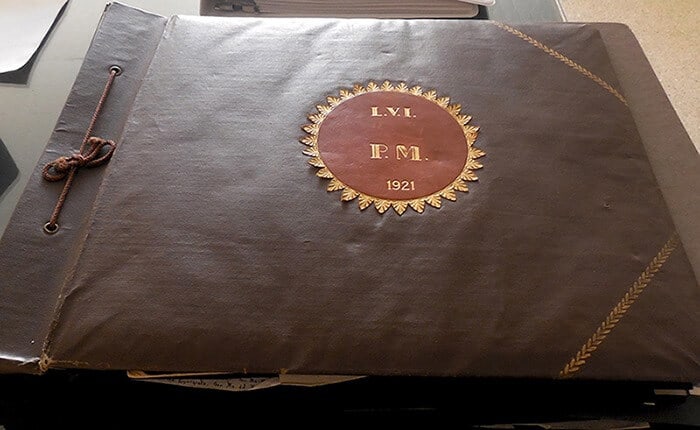Written by Hist. Liliana Totoricagüena Raya, Mexico City, Mexico.
Addressing the historical process of an archive is not an easy task, because the subjects in charge of the preservation of memory are not usually the protagonists since their work is considered administrative. For this reason, it is sometimes difficult to know their interaction or ways of working in the collection.
So, investigating how a document, a photograph, a magazine, a book, an interview, etc. reaches the archive is interesting and at the same time an enigma because each copy has a story of its own. It is as if a code were becoming visible in the light of archivists, since the cause and effect of certain phenomena and events would end up being understood. Therefore, thanks to our predecessors, it is possible to know the past and show solutions in the present, especially in the case of the Congregation of the Sisters of Charity of the Incarnate Word, in Casa San Ángel, the base of the congregation in Mexico.
For this reason, my intention in these brief lines is to emphasize those characters who in some way, directly or indirectly, contributed to the formation of the documentary collection of the Congregation of the Sisters of Charity of the Incarnate Word of the Mexican Province, since in some articles and publications from the same organization, they have generally highlighted the archival work done in San Antonio, Texas around the 1970s.
However, the circumstances in Mexico have been very different with regard to information, because each ministry has generated its own documentation and built its own history. On many occasions, the documentation has been dispersed in various communities, hospitals and schools belonging to the Congregation. For this reason, I can say that the first attempts to build the archive in San Ángel have undoubtedly been from the administrative side and the role of several sisters who were officially in charge of the secretariats of the Province. This can be seen in directories, publications, and correspondence from 1985 to 2020.
One of the many lucky cases that are preserved and that it is necessary to acknowledge her posthumous work, in archival matters, is that of Sister Isabel de la Trinidad Rodríguez, who served as Provincial Secretary from 1984 to 2008. Thus, she was in charge of the ordination of the correspondence between the Provincial and General Superiors. In addition, her concern was to keep the personal files of the active, outgoing and deceased sisters in order. The result was sensational, even for such an active administration as the Congregation’s, because these days, it allows us to understand the concerns of each administration and its future transformation.
In a similar field, we find the case of Sister Martha Irma Almanza, although as we know, her work was constituted in the field of communications, and thanks to this, she left a very important legacy in the field of spreading and she gave a turn to the issues that were dealt in each ministry mainly through the publications of “A Letter,” since from the first edition in 1989 and until Almanza’s death in 2004, the contributions of the sisters were known in a more direct and diverse way, not only among them, but also between the laity who participated in the activities and the congregational charism.

Editors working: Sr. Eilish Ryan (San Antonio), Sr. María Elena López (St. Louis), and Sr. Martha Irma Almanza (Mexico)
We have a lot to say about Sister Martha Irma Almanza from various perspectives in the journalistic field, but I would like to highlight some of the topics or items that have been beneficial in the documentary collection until today, now that “A Letter” reflected the institutional legacy of the ministries of Governance, Education, Health and Popular Pastoral essentially, since ordinary correspondence was only dealt with administrative and logistics matters on several occasions, which made it a bit monotonous. On the other hand, the distribution of the magazine seemed to have motivated the religious sisters in their work, and the collaborators, students and laity in their social contributions.
In the same way, around 2009 Sister Magdalena Caballero and Sister María del Socorro Fuentes were the successors of their colleague Sister Isabel de la Trinidad Rodríguez, as they continued with the pre-established order of the personal files and correspondence. Although as we know, this system worked in a practical way for any procedure related to the sisters. In the specific case of an archivist, they are not just piles of obsolete paper, now that it allows us to carry out more detailed studies, for example, statistics and prosopographic studies to give an account of how corporations change, their relationship with the social environment and give certain daily solutions.
 Towards the second decade of the 21st century, Sister María Luisa Vélez, when observing the importance and complexity of the archives, she promoted a more specialized classification of the documentation of the Congregation in Mexico, which is why she was considered the founder of the repository. Therefore, between 2010 and 2011 Sister María Guadalupe (Lupita) Moreno Flores assumed the leadership of the collection and her position officially appeared in the directory published on the 2013-2014 period. Her work increasingly approached the idea of a historical archive because she began to organize the most systematic information by ministries of Education, Health and Popular Pastoral.
Towards the second decade of the 21st century, Sister María Luisa Vélez, when observing the importance and complexity of the archives, she promoted a more specialized classification of the documentation of the Congregation in Mexico, which is why she was considered the founder of the repository. Therefore, between 2010 and 2011 Sister María Guadalupe (Lupita) Moreno Flores assumed the leadership of the collection and her position officially appeared in the directory published on the 2013-2014 period. Her work increasingly approached the idea of a historical archive because she began to organize the most systematic information by ministries of Education, Health and Popular Pastoral.

Sr. María Guadalupe (Lupita) Moreno Flores
The arduous work of Sr. Lupita Moreno should be pointed out, since she managed – in a general way – to create a first catalog to understand her successors or people interested in the research. However, the archive became more extensive with the passage of time and required a more complex organization to attend to the preservation, restoration, conservation, logistics and more constant use of electronic media.
In such circumstances, the Congregation requested the support of lay personnel to help resolve the situations presented in the archive. Thus, the intervention of Erika Suárez consisted, in the first instance, in the request for basic furniture in a documentary collection such as: Shelves, special folders, special boxes to store graphic, newspaper, audiovisual material and restoration materials. This is where Suárez’s work could be highlighted, since due to other tasks related to research and request of all the information created in the ministries, specifically the celebration of the Congregational Sesquicentennial, the documentary classification was pending.
So, this is how we see the changes and the needs of the collection in each time and circumstances. As for me, unlike my predecessor, it has been my responsibility to look after the specialized classification of information as a priority and then resume the conservation processes.
In conclusion, perhaps over time more names of collaborators will emerge, those who have allowed us to approach the realization of a useful archive that contributes to the creation of new visions, ideas and solutions that are presented to us.
However, as I pointed out -at the beginning of this writing- the people in charge of documentary value and importance tend to be taken for granted and we have not made at least a fair mention of them, since on many occasions, archival science is thought to be an activity of integration of materials in boxes without a sense or logic. In addition, people do not usually appreciate documentary collections because they consider them as “things of the past,” but we must remember that, thanks to those experiences, life lessons and contributions verified in this case by the sisters, they have managed to build a better country, and it is necessary to recognize their contributions.
Finally, and as a reflection on the commendable work of the Sisters of Charity of the Incarnate Word, reflected in the documentary collection, I will keep to myself a famous phrase by Spanish poet Antonio Machado
“…Traveler, your footprints are the only road, nothing else. Traveler, there is no road; you make your own path as you walk. As you walk, you make your own road, and when you look back you see the path you will never travel again. Traveler, there is no road; only a ship’s wake on the sea….“









0 Comments